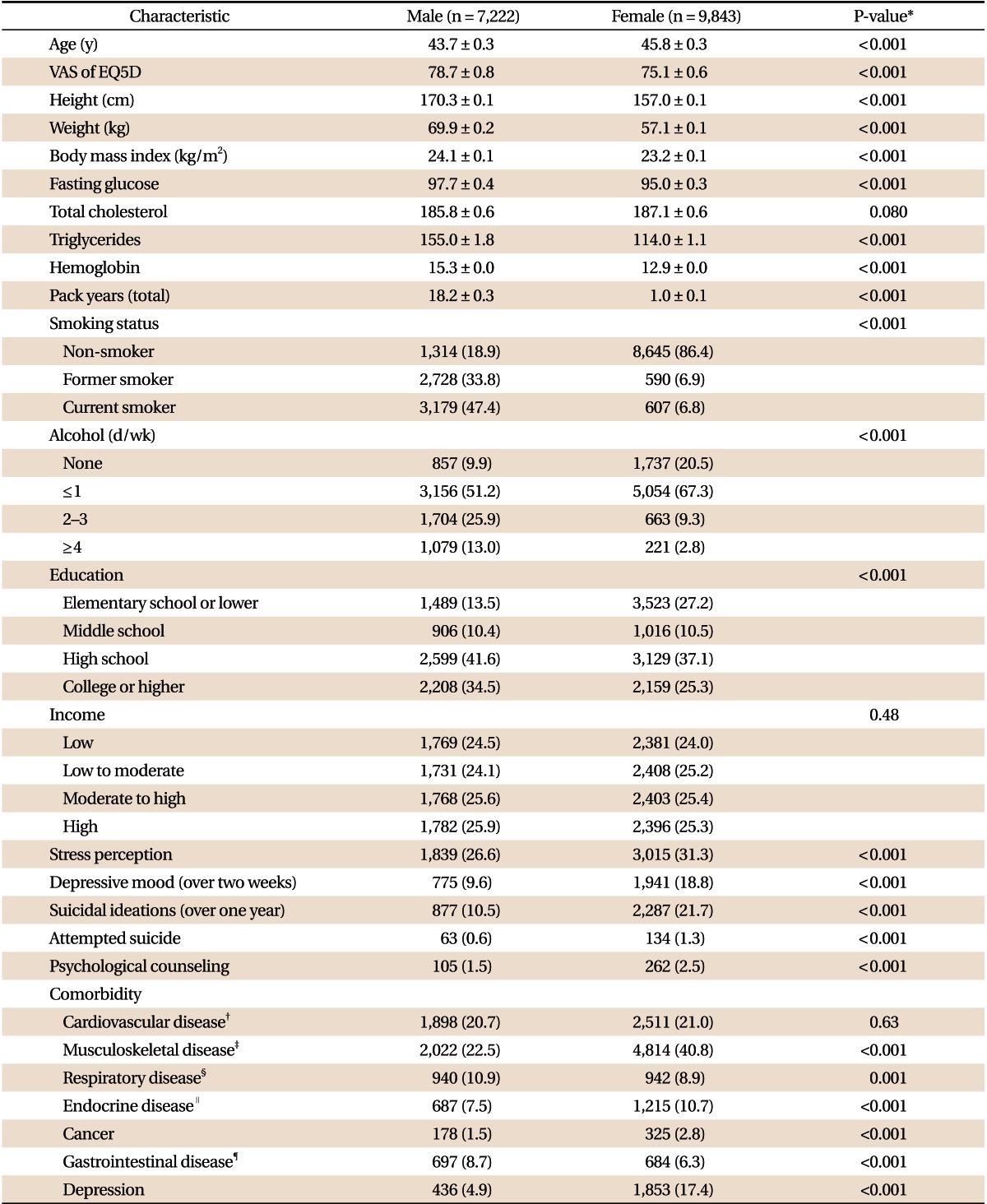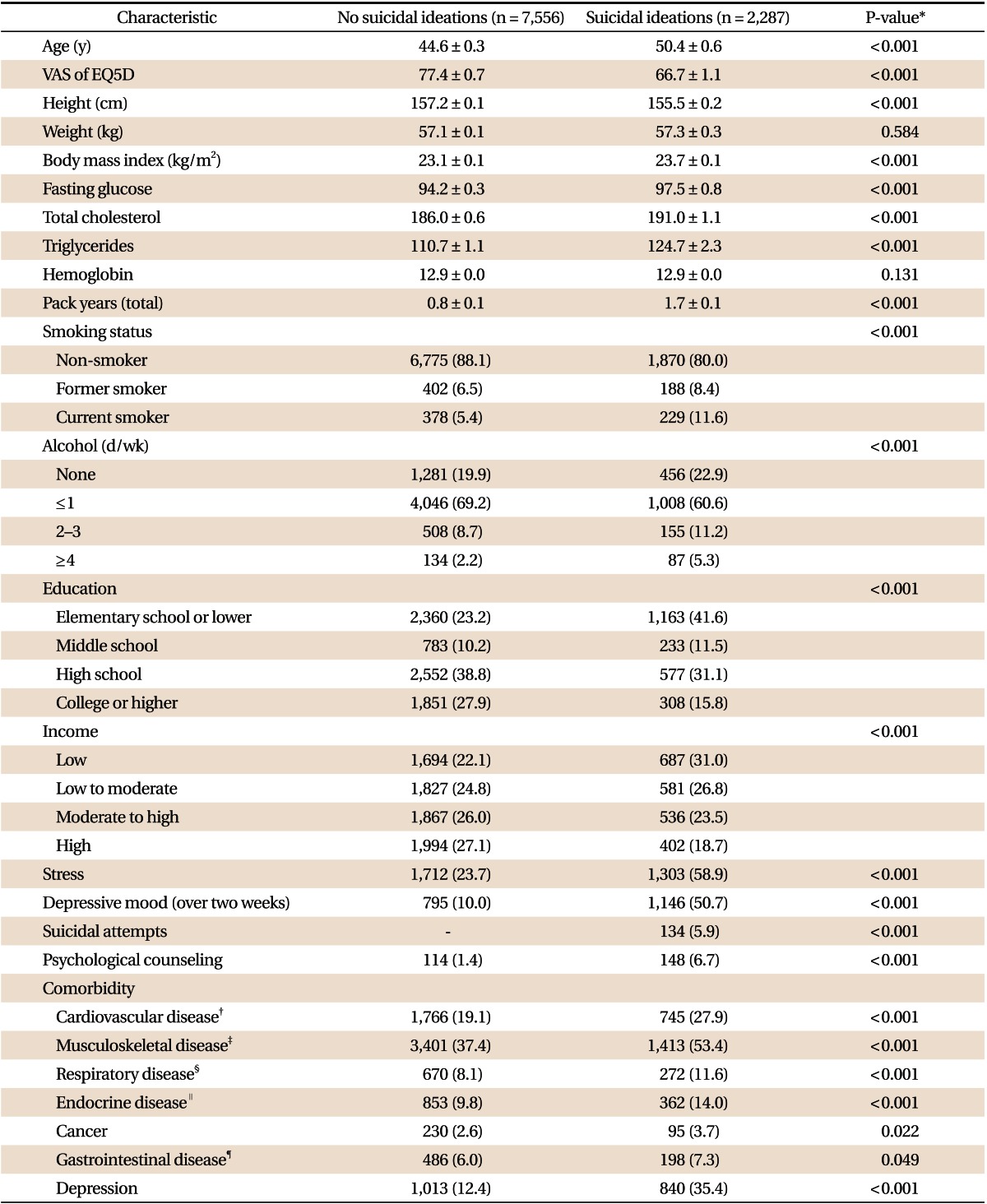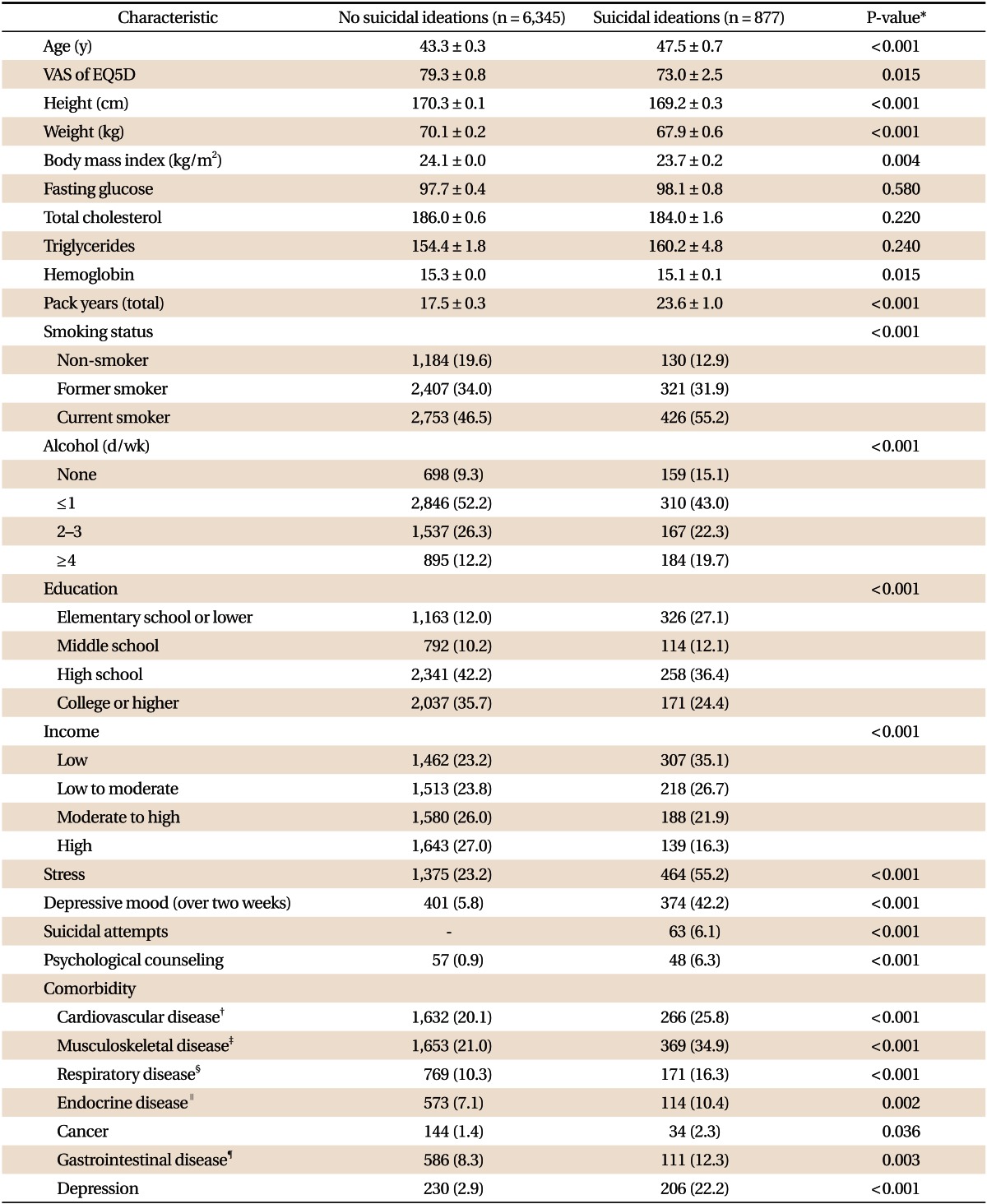 |
 |
- Search
| Korean J Fam Med > Volume 34(3); 2013 > Article |
Abstract
Background
Methods
Results
Conclusion
References
Table 1

Values are presented as mean ± SE or number (%). The numbers of subjects were not weighted, but the percentages of subjects were weighted. VAS of EQ5D: visual analog scale of Euroqol 5 dimension.
*By Student t-test or Pearson's chi-square test. †Hypertension, hyperlipidemia, cerebro vascular accident, myocardial infarction, angina pectoris. ‡Arthritis, rheumatoid arthritis. §Tuberculosis, asthma, chronic obstructive pulmonary disease. ∥Diabetus mellitus, thyroid disease. ¶Peptic ulcer, liver cirrhosis, hepatitis type B, hepatitis type C.
Table 2

Values are presented as mean ± SE or number (%). The numbers of subjects were not weighted, but the percentages of subjects were weighted. VAS of EQ5D: visual analog scale of Euroqol 5 dimension.
*By Student t-test or Pearson's chi-square test. †Hypertension, hyperlipidemia, cerebro vascular accident, myocardial infarction, angina pectoris. ‡Arthritis, rheumatoid arthritis. §Tuberculosis, asthma, chronic obstructive pulmonary disease. ∥Diabetus mellitus, thyroid disease. ¶Peptic ulcer, liver cirrhosis, hepatitis type B, hepatitis type C.
Table 3

Values are presented as mean ± SE or number (%). The numbers of subjects were not weighted, but the percentages of subjects were weighted. VAS of EQ5D: visual analog scale of Euroqol 5 dimension.
*By Student t-test or Pearson's chi-square test. †Hypertension, hyperlipidemia, cerebro vascular accident, myocardial infarction, angina pectoris. ‡Arthritis, rheumatoid arthritis. §Tuberculosis, asthma, chronic obstructive pulmonary disease. ∥Diabetus mellitus, thyroid disease. ¶Peptic ulcer, liver cirrhosis, hepatitis type B, hepatitis type C.
Table 4

Values are presented as mean ± SE or number (%). The numbers of subjects were not weighted, but the percentages of subjects were weighted.
VAS of EQ5D: visual analog scale of Euroqol 5 dimension.
*Twenty-nine participants from suicidal ideations only group did not answer to the question about attempted suicide. †By Student t-test or Pearson's chi-square test. ‡Hypertension, hyperlipidemia, cerebro vascular accident, myocardial infarction, angina pectoris. §Arthritis, rheumatoid arthritis. ∥Tuberculosis, asthma, chronic obstructive pulmonary disease. ¶Diabetus mellitus, thyroid disease. **Peptic ulcer, liver cirrhosis, hepatitis type B, hepatitis type C.
Table 5

Values are presented as mean ± SE or number (%). The numbers of subjects were not weighted, but the percentages of subjects were weighted. VAS of EQ5D: visual analog scale of Euroqol 5 dimension.
*Nine participants from suicidal ideations only group did not answer to the question about attempted suicide. †By Student t-test or Pearson's chi-square test. ‡Hypertension, hyperlipidemia, cerebro vascular accident, myocardial infarction, angina pectoris. §Arthritis, rheumatoid arthritis. ∥Tuberculosis, asthma, chronic obstructive pulmonary disease. ¶Diabetus mellitus, thyroid disease. **Peptic ulcer, liver cirrhosis, hepatitis type B, hepatitis type C.
Table 6

OR: odds ratio, CI: confidence interval.
*Adjusted for age, visual analog scale of Euroqol 5 dimension, height, weight, body mass index, fasting glucose, cholesterol, triglyceride, hemoglobin, alcohol intake, education, income, stress, depressive mood over two weeks, psychological counseling for one year, comorbid disease (depression), cardiovascular disease (hypertension, hyperlipidemia, cerebro vascular accident, myocardial infarction, angina pectoris), musculoskeletal disease (arthritis, rheumatoid arthritis), respiratory diseases (tuberculosis, asthma, chronic obstructive pulmonary disease), endocrine disease (diabetus mellitus, thyroid disease), gastrointestinal disease (peptic ulcer, liver cirrhosis, hepatitis type B, hepatitis type C).
Table 7

OR: odds ratio, CI: confidence interval.
*Adjusted for age, visual analog scale of Euroqol 5 dimension, height, weight, body mass index, fasting glucose, cholesterol, triglyceride, hemoglobin, alcohol intake, education, income, stress, depressive mood over two weeks, psychological counseling for one year, comorbid disease (depression), cardiovascular disease (hypertension, hyperlipidemia, cerebro vascular accident, myocardial infarction, angina pectoris), musculoskeletal disease (arthritis, rheumatoid arthritis), respiratory diseases (tuberculosis, asthma, chronic obstructive pulmonary disease), endocrine disease (diabetus mellitus, thyroid disease), gastrointestinal disease (peptic ulcer, liver cirrhosis, hepatitis type B, hepatitis type C).
- TOOLS






